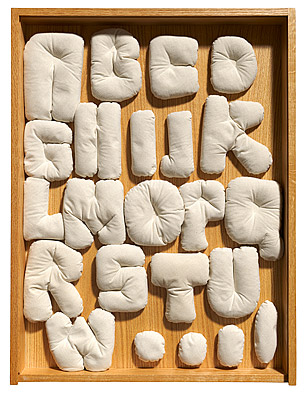Claes
OLDENBURG
Sweden
1929
United States of America from 1930
Soft alphabet
1978
wood, cloth, sand, stencil
16/16
edition of 16 plus 11 proofs
signed, in black pen "Oldenburg" [verso of box]
box (closed)
74.2 (h)
x 56.4 (w)
x 7.2 (d)
cm
Purchased 1982
National Gallery of Australia, Canberra
NGA 1982.1270.1-43
© Claes Oldenburg and Coosje Van Bruggen
Claes Oldenburg studied art and literature at Yale University before becoming a reporter in Chicago. Renouncing journalism, he attended the School of the Art Institute of Chicago and began publishing illustrations and comic strips in magazines. The influence of this early graphic career is obvious in Soft alphabet, where Oldenburg’s fascination with letters and language is evident.
Consisting of individual canvas pieces filled with sand and contained in a wooden box, the work seems straightforward at first. Plump, rounded, cartoon-like letters fit together snugly, according to the stencil outlined on their box’s lid. The gentle contours of the stuffed letters are rounded like a mouth as it forms a word, bringing tangibility to the abstract notion of sound, of words on a page. The work invokes pleasant connotations of both childhood alphabet games and a box of chocolates or sweets; the letters are the perfect size for the palm of your hand, seemingly encouraging you to touch or choose one.
Yet on closer inspection it becomes apparent that several of the letters are missing. The places of the E, F, N, V, X, Y and Z have been taken by odd, bean shaped objects. The bright, primary colours that are expected of children’s toys and confectionery wrappers are replaced with the bland, neutral colours of undyed canvas and unpainted wood. Suddenly the rather cutesy letters seem a bit sinister: why are they kept in a box, and where are the missing letters?
Emilie Owens
Administrative Assistant
International Art
National Gallery of Australia, Canberra

